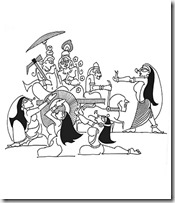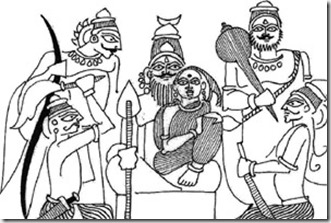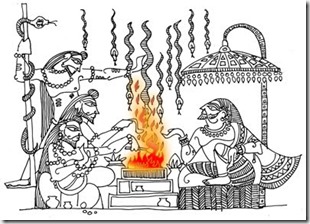Publisher: Penguin
Year: 2011
ISBN: 9780143104254
Rating:





Read book reviews from other readers
Being brought up in a family strongly bound by Hindu values and morals, my affair with the Mahabharata is a lengthy one. Right from childhood, my curiosity about this epic has made me read multiple versions of it – from the simple yet colorful illustrations of Amar Chitra Katha to the heavy and verbose retelling by C. Rajagopalachari. I have always felt that no matter how many versions you read, there is always something new that you learn with every version and Jaya confirms that belief.Jaya is a retelling of the Mahabharata, but with a few new ingredients that make it an appetizing dish for the mind. The feeling of ‘Great! Yet another version of the Mahabharata’ is completely erased after flipping through the first few pages of the book. This recital of the Mahabharata is presented systematically in 18 sections and 108 chapters, accompanied by simple yet artistic Madhubani-influenced line drawings and the author’s notes and deductions based on scientific and historic facts. The story is narrated by Astika, the nephew of Vasuki, the king of Nagas to Janamejaya, a descendant of the Pandavas, who has ordered the killing of all snakes in his land. The book also includes a short summary of the Bhagavad Gita, which abridges this complex book for the common man.
The author’s style of narration is simple, lucid yet sharp which reminded me of my grandmother‘s storytelling;  thus making the book even dearer to me. The side notes after every chapter that make comparisons among local folklore from different Indian states as well as versions of the Mahabharata from Indonesia give the reader a much deeper perspective on stories which would otherwise have been have overlooked. The author intervenes after each story to analyze the situation, activities and scenario to make the readers understand the reason behind the telling of each story. He articulates the evolution of Hindu rituals and beliefs from the Vedic times to recent history in an eloquent manner. This is what distinguishes the book from the other versions of the Mahabharata that I have read. It is also an indicator of the amount of research effort the author undertook to give out such splendid details. Even though the epic is a complex one with a lot of links connecting the characters, the author manages to seamlessly intertwine the characters and plots so that the reader does not have a hard time remembering the earlier mentioned related events; truly a feat when it comes to retelling an epic as detailed as the Mahabharata.
thus making the book even dearer to me. The side notes after every chapter that make comparisons among local folklore from different Indian states as well as versions of the Mahabharata from Indonesia give the reader a much deeper perspective on stories which would otherwise have been have overlooked. The author intervenes after each story to analyze the situation, activities and scenario to make the readers understand the reason behind the telling of each story. He articulates the evolution of Hindu rituals and beliefs from the Vedic times to recent history in an eloquent manner. This is what distinguishes the book from the other versions of the Mahabharata that I have read. It is also an indicator of the amount of research effort the author undertook to give out such splendid details. Even though the epic is a complex one with a lot of links connecting the characters, the author manages to seamlessly intertwine the characters and plots so that the reader does not have a hard time remembering the earlier mentioned related events; truly a feat when it comes to retelling an epic as detailed as the Mahabharata.
The illustrations are yet another notable feature of this book- be it Sarathi advising Arjuna on his chariot or the baby parrots who heard the war happen in Kurukshetra or the battle between Shikandi and Bhishma or Krishna after the Kurukshetra war, resting under a tree, the artwork is simple yet detailed. Their beauty lies in their simplicity; these images speak for themselves and summarize the stories beautifully.
The beauty of a book lies in how far it reaches out to its readers, and Jaya accomplishes that very easily. This is one of the best re-tellings of a timeless epic, through which Devdutt Pattanaik makes his mark as a master storyteller.
Read our reviews of Myth=Mithya, Sita, The Pregnant King and Gauri and the Talking Cow by Devdutt Pattanaik, and also enjoy our interviews with him here and here.
Vanathi Parthasarathi
Latest posts by Vanathi Parthasarathi (see all)
- Toni Morrison is back! - March 12, 2016
- Review: Shopaholic to the Stars by Sophie Kinsella - April 6, 2015
- Tharoor – Another Modi Fan? India Shastra proves not! - March 17, 2015


2 Comments
Review: Shikhandi and Other Tales They Don’t Tell You by Devdutt Pattanaik - Bookish
Review : The Pregnant King - Bookish